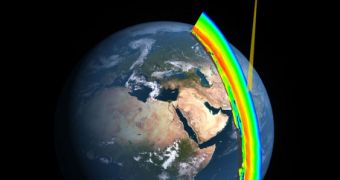Officials from the US National Oceanic and Atmospheric Administration (NOAA) announce that the Ozone Mapper Profiler Suite (OMPS) instrument aboard the Suomi NPP satellite has been successfully turned on.
The spacecraft launched to orbit on October 28, 2011, aboard a Delta II delivery system, from the Space Launch Complex 2W (SLC-2W) at the Vandenberg Air Force Base (VAFB), in California.
Its role is to bridge the gap between the NOAA Polar Operation Environmental Satellite (POES) constellation and the American space agency's Earth Observing System (EOS) satellite series, on one hand, and the upcoming Joint Polar Satellite System (JPSS), which is currently under development.
The spacecraft was previously known as the National Polar-orbiting Operational Environmental Satellite System (NOESS) Preparatory Project (NPP). It was renamed on January 24, 2012, after the father of modern satellite meteorology, Verner E. Suomi.
The satellite carries a suite of five scientific instruments. Experts have been working on bringing all of them online following the launch. OMPS is the latest to be activated. It's basically made up of a group of imaging spectrometers.
Its primary purpose is to measure and map the health of the ozone layer above Earth's poles in particular, but also in other areas of interest. Knowing how the ozone layer behaves is essential to our very survival, since it protects us from harmful ultraviolet radiations from the Sun.
Chemicals such as chlorofluorocarbons (CFCs) and halons, which do not occur naturally, release dangerous compounds such as bromine and chlorine into the atmosphere. These substances then go on to attack ozone (O3), breaking it apart and making Earth's UV-protection layer thinner.
“Ozone depletion has been a major concern for decades. Scientists need reliable technology that tracks ozone from space, and OMPS gives us the opportunity,” NOAA Satellite and Information Service assistant administrator Mary Kicza explains.
“With the large ozone depletion seen in the Arctic in March 2011, it was critical to get OMPS into orbit for measurements in the Northern Hemisphere,” concludes NASA scientist Paul Newman, who is also the co-chair of the United Nations Montreal Protocol Scientific Assessment Panel.

 14 DAY TRIAL //
14 DAY TRIAL //